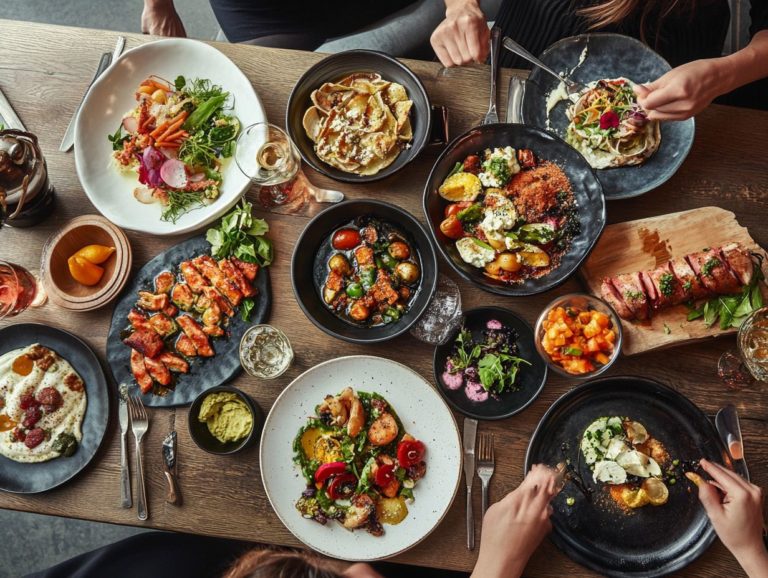The Role of Senses in Mindful Eating Practices
Mindful eating transcends mere trendiness; it s a transformative practice that invites you to reconnect with both your food and yourself.
By honing in on the sensations of eating, you have the opportunity to cultivate healthier habits and elevate your overall well-being. This article delves into the concept of mindful eating, illustrating how your senses are pivotal in shaping your culinary experiences.
You ll find practical tips to engage your senses, explore the myriad benefits of this approach, and address common challenges that may emerge. Discover how being present with your food can lead you to a more fulfilling and nourishing life.
Contents
- Key Takeaways:
- The Concept of Mindful Eating
- The Role of Senses in Mindful Eating
- Using Senses to Practice Mindful Eating
- Benefits of Mindful Eating
- Challenges and Solutions for Mindful Eating
- Frequently Asked Questions
- What are the five senses and how do they play a role in mindful eating practices?
- How can using the sense of sight help with mindful eating practices?
- Why is the sense of smell important for mindful eating?
- How can touch be incorporated into mindful eating practices?
- What role does the sense of hearing play in mindful eating practices?
- Can mindful eating practices help with portion control?
Key Takeaways:

- Mindful eating involves being fully present and aware while consuming food, allowing for a deeper appreciation of the eating experience.
- Our senses, such as taste, smell, and sight, play a significant role in our eating habits and can be used as powerful tools for practicing mindful eating.
- Incorporating sensory techniques, such as savoring each bite and listening to hunger cues, can aid in cultivating a more mindful approach to eating and ultimately lead to improved overall well-being.
The Concept of Mindful Eating
Mindful eating is a holistic approach that helps you be more aware of what you re eating and forge a deeper connection with your food. It encourages you to tune into your internal cues hunger and feeling full rather than being swayed by external factors like portion sizes or the appearance of meals.
By embracing mindfulness during your eating experience, you can develop a richer appreciation for your food choices and foster a sense of gratitude for each meal. This practice enhances the quality of your diet and acts as a powerful tool against emotional eating, which is when you eat in response to feelings, not hunger. This makes it an essential component of effective health promotion strategies.
Defining Mindful Eating
Mindful eating invites you to be fully present at the table, tuning into your body s internal signals of hunger and fullness instead of getting sidetracked by external distractions or portion sizes.
Imagine pausing to admire the vibrant colors and unique textures of your meal before you take that first bite. By savoring each flavor and truly noticing the sensations of chewing and swallowing, you cultivate a more intentional relationship with your food. This practice encourages you to eat slowly and resist the urge to multitask, enhancing your overall dining experience.
Now, think about mindless eating grabbing snacks while binge-watching your favorite show or racing through meals. It s easy to see how mindful eating nurtures a deeper appreciation for nutrition and can elevate the quality of your diet. By making thoughtful choices and becoming aware of your body s signals, you not only recognize when you re satisfied but also promote a healthier lifestyle.
The Role of Senses in Mindful Eating
The senses are essential to the art of mindful eating, shaping how you perceive and relish your meals. By engaging all five senses—sight, smell, taste, touch, and hearing—you can significantly enrich your dining experience and make more intentional food choices by understanding the psychology behind mindful eating.
Imagine appreciating the vibrant colors of your meal or inhaling the delightful aromas wafting from a dish; these moments can elevate your enjoyment and awareness. Savoring small bites amplifies the flavors you experience and helps you tune into satiety signals, nurturing a deeper connection to your emotional landscape.
How Senses Influence Eating Habits

Your senses have a profound influence on your eating habits. They shape what you choose to eat and how much you feel like eating, affecting your appetite control.
This intricate relationship begins with the appearance of food. Vibrant colors and artful presentations can entice you to opt for healthier choices, while dull or unappealing dishes might nudge you toward less nutritious options.
Your sense of smell plays a crucial role as well. Enticing aromas can spark cravings and heighten your appetite, guiding your decisions even before that first bite.
By engaging in mindful eating practices, you can cultivate awareness of these sensory triggers. This leads to more conscious food choices and deepens your appreciation for flavors, textures, and aromas. It also fosters healthier eating habits and enhances your overall well-being.
Using Senses to Practice Mindful Eating
To truly embrace mindful eating, integrate a range of practices that engage your senses before, during, and after meals. Treating intentional meal preparation as an opportunity for mindfulness can transform the act of cooking into a form of meditation.
Tuning into how food feels, smells, and looks can elevate your dining experience. Savoring small bites encourages a slower pace of eating and enhances your awareness of your body. This sharpens your ability to recognize subtle cues of hunger and fullness.
Tips and Techniques for Incorporating Senses
Incorporating your senses into mindful eating can elevate your meal experience. Focus on food preparation and take the time to truly enjoy each bite.
Creating a mindful kitchen environment is essential to this practice. Declutter your space to foster a sense of calm, and consider using beautiful utensils that spark your curiosity.
Paying attention to the textures of your food can deepen your engagement. Imagine feeling the satisfying crunch of fresh vegetables or the velvety creaminess of ripe avocados. These sensations can heighten your awareness and enjoyment.
Practicing gratitude before meals helps you forge a more meaningful connection with your food. This invites positive emotions that enhance the pleasure of each bite. Explore these strategies and discover unique approaches that resonate with you, leading to a richer culinary experience.
Benefits of Mindful Eating
Mindful eating offers incredible benefits that can transform your relationship with food! It greatly enhances your eating habits and overall emotional well-being. It also serves as a natural approach to weight management and dietary enhancements.
By cultivating a deeper connection with food and sharpening your awareness of bodily signals, you can make more informed food choices that elevate your diet s quality.
This holistic approach not only helps reduce emotional eating but also fosters healthier relationships with food. Ultimately, this curbs weight gain and promotes lasting lifestyle changes.
Improved Eating Habits and Overall Well-being

Improved eating habits stemming from mindful eating practices can significantly enhance your overall well-being. This allows you to reconnect with your emotional senses.
By honing in on the experience of eating enjoying each bite, appreciating the intricate flavors, and recognizing the cues of hunger and fullness you can cultivate a profound awareness of your food choices.
This mindful approach not only encourages better food choices, like incorporating more fruits, vegetables, and whole grains into your diet, but also elevates the enjoyment of your meals.
Imagine taking the time to prepare a vibrant salad brimming with fresh ingredients, allowing yourself to appreciate the textures and colors, which ultimately leads to greater satisfaction.
Mindful eating can be your secret weapon against emotional eating. As you learn to distinguish between physical hunger and emotional triggers, you can develop healthier habits.
Techniques like mindful breathing before meals or creating a serene dining atmosphere can reinforce these positive practices. They promote not only mental clarity but also emotional health.
Start your mindful eating journey today and discover the joy of every bite!
Challenges and Solutions for Mindful Eating
While mindful eating offers many benefits, it also introduces challenges that can hinder your journey toward establishing those paying attention to what you eat habits, especially in situations involving not having enough food or mental health struggles.
You might find that focusing on your meal experience is difficult when external factors or emotional states disrupt your ability to be present.
However, recognizing these obstacles opens the door to practical solutions that can seamlessly integrate mindful eating into your daily life.
Overcoming Obstacles and Maintaining Mindful Eating Habits
Overcoming barriers to mindful eating requires a comprehensive approach. Leveraging community resources and making deliberate food choices are essential.
Connecting with like-minded individuals can take your mindful eating journey to the next level! It not only reinforces positive habits but also enhances accountability.
Meal planning is a powerful strategy; it helps you prepare balanced meals in advance, effectively curtailing impulsive food decisions that often derail progress.
Creating a home environment that supports healthier food choices involves mindful grocery shopping. Focus on whole foods and avoid processed options that can undermine your efforts. Local community centers often host valuable workshops and support groups centered on nutrition, providing enriching learning opportunities and much-needed encouragement.
By utilizing these resources, you can cultivate a nurturing environment that fosters healthy eating behaviors, making your path to mindful eating not just attainable but truly rewarding.
Frequently Asked Questions
What are the five senses and how do they play a role in mindful eating practices?

The five senses include taste, sight, smell, touch, and hearing. Paying attention to each of these senses while eating can help increase awareness and enjoyment of the food.
How can using the sense of sight help with mindful eating practices?
Using your sense of sight can enhance mindful eating by allowing you to visually appreciate the appearance of the food, which increases anticipation and aids in portion control.
Why is the sense of smell important for mindful eating?
The sense of smell enhances the flavor and enjoyment of food. Taking a moment to smell your food before eating helps recognize when you are truly hungry.
How can touch be incorporated into mindful eating practices?
Touch can be incorporated by paying attention to the texture and temperature of the food. This helps savor the meal and recognize when the food is at the right temperature for eating.
What role does the sense of hearing play in mindful eating practices?
The sense of hearing plays a role by making you aware of the sounds associated with eating, like the crunch of vegetables or the sizzle of food cooking. This enhances the overall sensory experience of eating.
Can mindful eating practices help with portion control?
Yes, mindful eating practices can aid in portion control by increasing awareness of hunger and fullness cues. Taking the time to truly enjoy and savor each bite helps prevent overeating and promotes a healthier relationship with food.
Start your mindful eating journey today!






